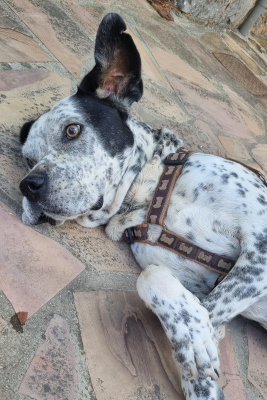In 2018, 471 million dogs were kept as pets worldwide. That is a lot, and most of you probably own a dog too. In this case, it could be interesting to learn a little bit more about your best friend.

There are several hundred breeds of “domestic dogs”: Golden Retriever, Labrador, Border Collie, Poodle, German shepherd, Chihuahua , Akita, these are the breeds on top of my head right now. If you look at pictures of the different breeds, you almost can’t believe that they are related to each other. But they actually all belong to the same species, even though they drastically vary in appearance. Canis familiaris is the name of the species, and that is also what differentiates our dogs we keep as pets from wild canines like foxes, wolves, and coyotes.
Nevertheless, dogs are descended from the grey wolf. The differences to wolves are huge. Not only the appearance but also the behavior differs from breed to breed. It is known due to DNA findings that domestication might have happened twice, so that there are two unique common ancestors. This happened about 130,000 years ago. The different breeds, however, resulted from the artificial “evolution” of dogs by humans by selectively breeding them for years.

The first people began breeding dogs in order for them to survive and work in the cold. These dogs would become the family of sled dogs, so huskies or malamutes. We know these breeds until today.
Many more breeds were created to fill other human needs. For instance, the sausage-shaped Dachshunds are able to rush down a burrow after a badger. Or the Labrador retrievers to help collect ducks. Also, for home protection as well as vermin control, other breeds were created. Other breeds don’t really help humans with anything work-related but only make dogs more desirable as companions.
Nowadays, dogs have different kinds of jobs than back in the day. They assist law enforcement by sniffing out explosives, drugs, or electronics.
Additionally, dogs support search and rescue teams. Due to natural disasters or reports of people lost in the outdoors, specifically trained dogs can, for example, find the survivors or even dead bodies. There are also military dogs who are trained to warn of hidden explosives and enemies. Furthermore, dogs also work in the medical field. They can sniff out early signs of Parkinson’s disease, diabetes, cancer, oncoming epileptic seizures, and many more. There are guide dogs for blind or death people and there are also dogs that help people with autism or psychological disorders manage their anxiety.
In these cases, we rely on dogs because of their outrageously good sense of smell: dogs smell between 10.000 and 100.000 times better than humans!
Most dogs, though, are mixed breeds and are only there as friends of the humans. Only a few are specifically trained and have the concentration and patience to do such important work like what I listed earlier. When dogs are cared for properly and treated with respect, they can be loving, playful, and intelligent, but not every dog has the potential to be a guide dog, for example.
Plus, you should always show respect for dogs you don’t know. Because dogs are, after all, still animals with their own minds and with sharp teeth. Please always ask the owner before petting a dog you don’t know. There is always the possibility that you could be bitten by it.

An easy way to understand a dog’s feelings more is to look closely at its body language. Of course, barking, whining, and growling are part of dogs’ communication too, but more often dogs rely on posture, facial expressions, and other body language.
Let’s start with understanding how to interpret tail wagging. It is not always a sign that the dog is happy, as many people think. It is just a sign of emotional arousal. That also includes excitement, or even frustration. Here, you have to look closely at the speed and direction, as well as the position of the tail.
Basically, the faster the tail wags, the more excited the dog is. Consider the long, slow, sideways tail movements your dog makes when saying hello—the kind where the dog wags his whole body. That’s a relaxed dog. A faster, twitching tail wag is indicative of a higher level of excitement, and potentially in a negative way. Think of a guard dog on alert.
The position of the tail is of even greater importance. If your dog’s tail is pointing down to the ground or even tucked between their legs, it is a sign of stress and fear. The higher the tail, the more energetic the dog. If the dog is relaxed, the tail is in its neutral position.
To put it all in a nutshell, you should have learned something about the evolution of modern dogs, how some breeds came into being, how dogs help us in our daily life, and how to interpret a dog’s behavior. I hope you were able to check these raster points and gained some knowledge from my article. Have a nice rest of your week. I look forward to seeing you on our website again!
Sources:
https://www.statista.com/statistics/1044386/dog-and-cat-pet-population-worldwide/ (Emma Bedford,11.10.2022)
https://www.nationalgeographic.com/animals/mammals/facts/domestic-dog (nationalgeographic, 11.10.2022)
https://www.pbs.org/wgbh/evolution/library/01/5/l_015_02.html (PBS, 12.10.2022)
https://www.akc.org/expert-advice/advice/how-to-read-dog-body-language/ (Stephanie Gibeaults, 12.10.2022)

